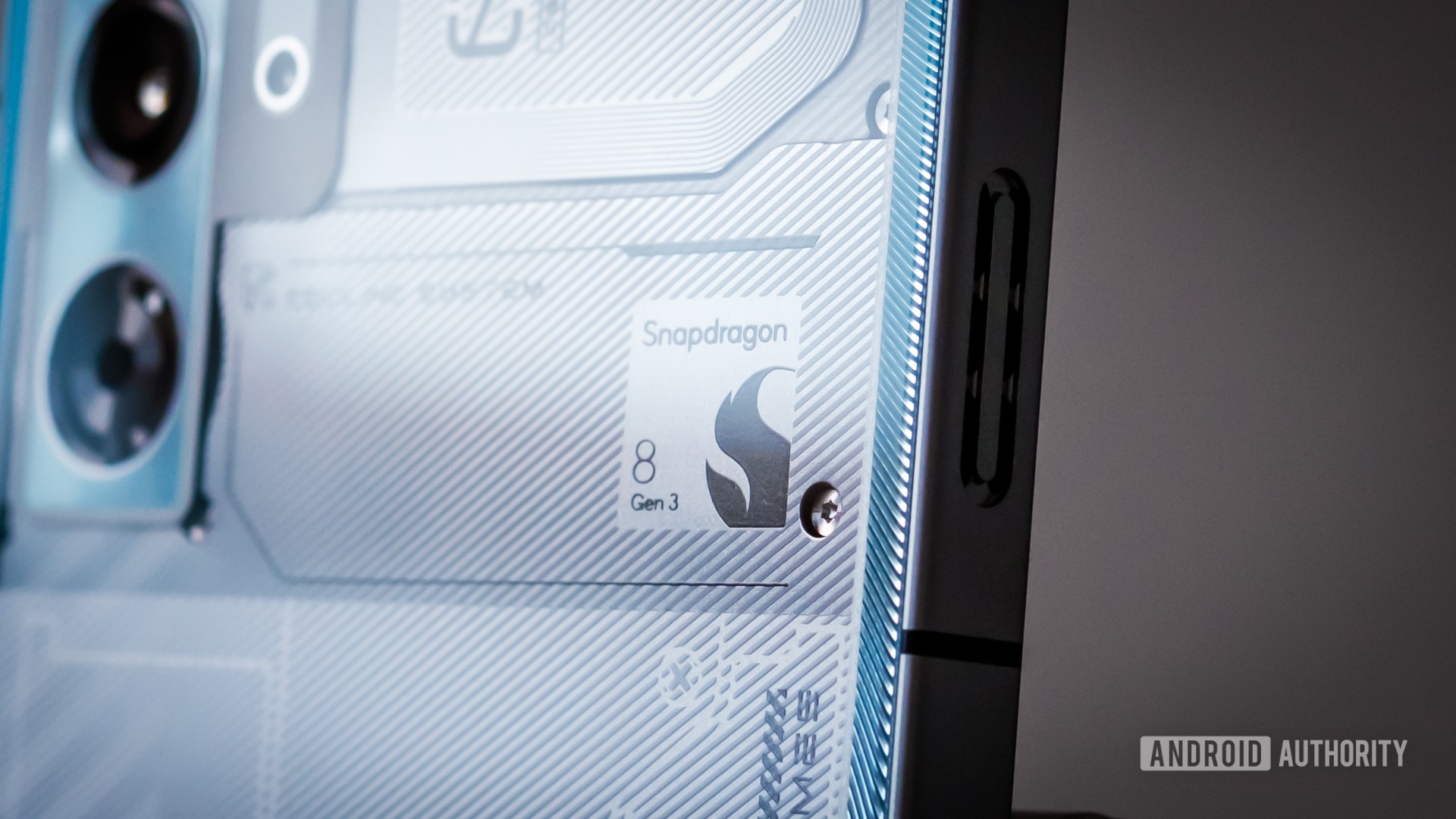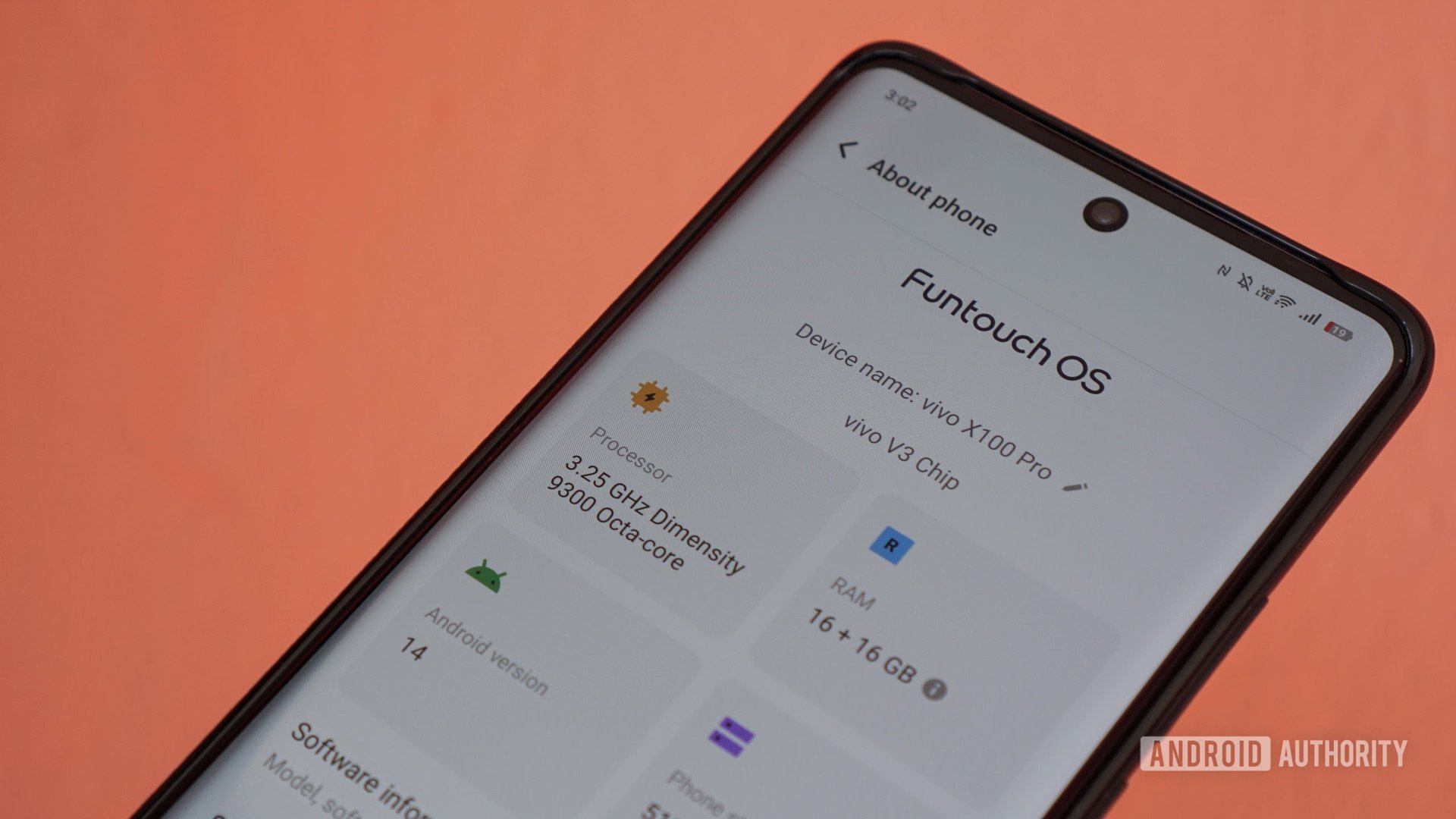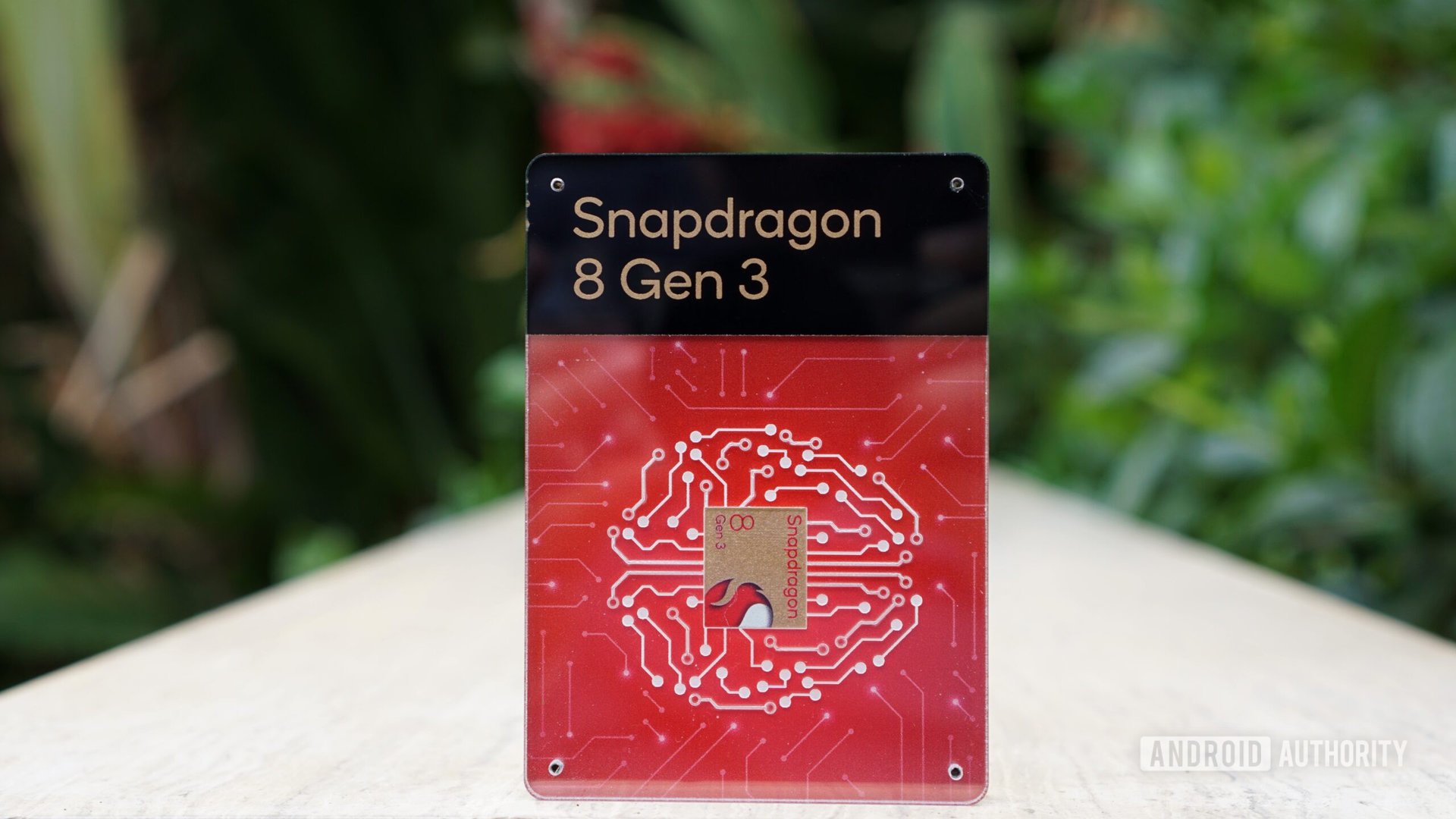Affiliate links on Android Authority may earn us a commission. Learn more.
Snapdragon 8 Gen 3 vs Dimensity 9300 benchmarked: There can only be one winner

Qualcomm announced its Snapdragon 8 Gen 3 chipset in October, 2023 while MediaTek announced its Dimensity 9300 in November. These chipsets are expected to power a host of flagship phones in 2024, but device makers are wasting little time in adopting these processors.
We’ve already seen handsets with both the Snapdragon 8 Gen 3 and Dimensity 9300 launching. We got our hands on the Snapdragon-toting REDMAGIC 9 Pro and the Dimensity-equipped vivo X100 Pro. This gives us the first opportunity to see how these new chipsets fare against each other in real-world devices.
Snapdragon 8 Gen 3 vs Dimensity 9300 specs

The two processors have a few features in common, like a TSMC 4nm process, Bluetooth 5.4, and support for hardware-based ray tracing. But otherwise, you’re looking at two divergent approaches.
| Snapdragon 8 Gen 3 | Dimensity 9300 | |
|---|---|---|
CPU Config | Snapdragon 8 Gen 3 1x 3.3GHz (Cortex-X4) 3x 3.2GHz (Cortex-A720) 2x 3GHz (Cortex-A720) 2x 2.3GHz (Cortex-A520 Refresh) | Dimensity 9300 1x 3.25GHz (Cortex-X4) 3x 2.85GHz (Cortex-X4) 4x 2GHz (Cortex-A720) |
GPU | Snapdragon 8 Gen 3 Adreno Ray tracing support Global illumination | Dimensity 9300 Arm Immortalis-G720 MC12 Ray tracing support Global illumination |
DSP | Snapdragon 8 Gen 3 Hexagon (fused scalar, tensor, and vector) Mixed precision INT8/INT16 INT4 support | Dimensity 9300 APU 790 INT8/INT16 INT4 support |
RAM support | Snapdragon 8 Gen 3 LPDDR5X | Dimensity 9300 LPDDR5T |
Camera | Snapdragon 8 Gen 3 • 200MP single shot • 108MP single with zero shutter lag • 64MP+36MP with zero shutter lag • Triple 36MP with zero shutter lag • Dolby HDR photo • Real-time semantic segmentation for photos and videos (up to 12 layers) • 8K/30fps HDR video • 4K/120fps slow-motion | Dimensity 9300 • 320MP single shot • HDR video • Real-time semantic segmentation for photos and videos (up to 16 layers) • 8K/30fps • 4K/60fps |
Charging | Snapdragon 8 Gen 3 Quick Charge 5 | Dimensity 9300 USB-PD PPS |
4G/5G Modem | Snapdragon 8 Gen 3 X75 LTE/5G (integrated) 10,000Mbps down 3,500Mbps up | Dimensity 9300 LTE/5G (integrated) 7,000Mbps down |
Other networking | Snapdragon 8 Gen 3 Bluetooth 5.4 Wi-Fi 7, Wi-Fi 6/6E (802.11ax), Wi-Fi 5 (802.11ac), 802.11a/b/g/n | Dimensity 9300 Bluetooth 5.4 Wi-Fi 7, Wi-Fi 6/6E (802.11ax), Wi-Fi 5 (802.11ac), 802.11a/b/g/n |
Process | Snapdragon 8 Gen 3 TSMC 4nm (N4P) | Dimensity 9300 TSMC 4nm (4nm+) |
Qualcomm adopts a 1+5+2 CPU layout, featuring one big Cortex-X4 core, five medium Cortex-A720 cores, and two little Cortex-A520 cores. This means we’ve got one more medium core and one less little core compared to the previous flagship Snapdragon chip.
Qualcomm is amping up the clock speed here too. All of these cores are running at a higher frequency than their counterparts on the vanilla Snapdragon 8 Gen 2. That combo of higher clock speed plus newer CPU cores is pretty promising, on paper.
Meanwhile, the Dimensity 9300 eschews little cores entirely in favor of four Cortex-X4 CPU cores and four medium Cortex-A720 cores. This is a very aggressive approach at first glance.
The Dimensity 9300 brings a higher clock speed for the big X4 core, but the three other X4 cores feature a reduced 2.85GHz clock speed in line with the medium A715 cores seen in the Dimensity 9200. Meanwhile, the four Cortex-A720 medium cores here are clocked at just 2GHz. In other words, MediaTek has loads of big and medium cores, but it isn’t running all of them at full tilt, so we’re curious to see what this means for multi-core workloads.
Qualcomm also brings its top-notch Adreno GPU and X75 modem, while MediaTek relies on its in-house modem and Arm’s Immortalis-G720 MC12 graphics.
Snapdragon 8 Gen 3 vs Dimensity 9300 benchmarks
Apple’s A17 Pro still beats both Android processors when it comes to single-core and multi-core CPU performance. And the single-core advantage is particularly massive. However, it’s a closely fought contest for second place between the new Android chips.
The Snapdragon 8 Gen 3 inside the REDMAGIC 9 Pro has a slight edge when it comes to single-core scores, while the Dimensity 9300 in the vivo 100 Pro delivers a close multi-core win. It’s close enough that the results could conceivably go either way with another manufacturer’s phone.
You’d think that MediaTek’s chip would run away in the multi-core test given the use of four heavy-lifting Cortex-X4 cores. But don’t forget that only one of these cores is clocked above 3GHz (3.25GHz, to be precise), while the three other X4 cores max out at 2.85GHz. Combined with Qualcomm’s decision to offer more cache and increased clock speeds on six cores, and the Dimensity 9300 edges out the Snapdragon chip by only a small margin.
CPU testing shows that the Snapdragon 8 Gen 3 and Dimensity 9300 are very evenly matched for app workloads.
GPU testing via 3DMark represents a significant win for the Snapdragon 8 Gen 3, though. The one-off Wild Life test shows a massive ~26% advantage for the Snapdragon-toting REDMAGIC phone. The Dimensity 9300 phone still beats the iPhone 15 Pro and the Galaxy S23 Ultra, but there’s certainly a gulf to the Snapdragon 8 Gen 3 handset.
It’s also interesting to note that the Solar Bay ray tracing test shows an almost ~21% advantage for Qualcomm and REDMAGIC. This is an about-turn compared to early this year when the Dimensity 9200 was the big winner in ray tracing benchmarks. The Snapdragon 8 Gen 2 was able to narrow the gap in these tests thanks to updates, but it still lagged behind. So it seems like the combination of a more powerful GPU plus optimizations is paying off big-time. Not that we’re seeing many mobile games using ray tracing in the first place.
Snapdragon 8 Gen 3 vs Dimensity 9300 stress testing
Once-off benchmark tests only give us an idea of peak performance. But who cares about Apple-beating speeds if it can only be sustained for two seconds? That’s why we put the Snapdragon 8 Gen 3 and Dimensity 9300 phones through some GPU stress testing. This is more demanding than real-world gaming scenarios but still gives us an idea of what to expect in extremely long gaming sessions, lengthy bouts of video recording, and other similarly demanding persistent use cases. It’s normal to see some throttling in these tests, but which one throttles more?
The REDMAGIC 9 Pro understandably dominates the Wild Life stress test with the cooling fan enabled in performance mode. Disable the active cooling, however, and we see major dips and peaks before settling into some rock-solid performance from run five onwards. This is still a significant drop overall, representing 67% stability, and is actually below peak Snapdragon 8 Gen 2 and Dimensity 9200 scores.
As big of a drop as the REDMAGIC 9 Pro experiences, the vivo X100 Pro and Dimensity 9300 deliver a far more unstable experience over the length of the test. The phone only maintained 44% stability by the end, meaning its performance dropped by well over half. What’s even more concerning is the fact that the Galaxy S23 Ultra, using the older Snapdragon 8 Gen 2 for Galaxy chip, ultimately managed to edge out the Dimensity handset. Even the Dimensity 9200-toting vivo X90 Pro is nipping at its successor’s heels.
Things aren’t any more encouraging when we take a look at the Wild Life Extreme stress test. This pushes the phones even more, and the REDMAGIC phone drops 30% of its performance out-of-the-box when going from the first run to the second run. But it manages to maintain this performance all the way to the end, which is pretty respectable.
The Dimensity 9300 gradually drops performance, but this is heavily dependent on the level of cooling and workload.
By comparison, the vivo X100 Pro started significantly behind the Snapdragon 8 Gen 3 but grabbed the lead from the second run. The phone only held onto the lead until run seven, owing to a steady decline that continued for the rest of the test. This is interesting, as it suggests the chip may hold up quite well in real games that aren’t as stressful as this test. However, the Dimensity 9300 phone otherwise yielded an abysmal 48.2% stability. This performance ultimately puts it well below the Dimensity 9200 and Snapdragon 8 Gen 2’s final scores.
The Solar Bay ray tracing stress test also sees similarly poor performance from the MediaTek chip, resulting in just 47.4% stability. It ends up being beaten by the Snapdragon 8 Gen 2 and Apple A17 Pro. In fact, the Dimensity 9200 manages to edge out its successor again.
Stress testing shows a clear win for the Snapdragon 8 Gen 3, as the Dimensity 9300 gives up a ton of performance. But Qualcomm's chip is far from flawless.
The Snapdragon 8 Gen 3 inside the REDMAGIC 9 Pro doesn’t fare much better, dropping performance by roughly a third out-of-the-gate but still holding steady for the rest of it to easily beat its rivals. Strangely enough, turning on the REDMAGIC’s cooling fan results in rock-solid performance until run 17, when it registers a mammoth ~62% decline before ending with a ~75% overall drop. It seems like not even a cooling fan can tame this dragon when pushed to absolute extremes.
It should also be noted that the REDMAGIC 9 Pro is a gaming phone. So it’s possible that more conventional Snapdragon 8 Gen 3 phones could see big drops in peak benchmark scores owing to less than adequate cooling and more conservative performance targets. The REDMAGIC phone packs an array of passive cooling features as well as a cooling fan, but the latter was only activated when running tests in performance mode. Either way, the MediaTek Dimensity 9300 is the big loser in stress testing. But the Snapdragon 8 Gen 3 doesn’t emerge unscathed at all.
Dimensity 9300 vs Snapdragon 8 Gen 3: Which one is better?

It’s clear that Qualcomm and MediaTek’s new chips are on an even footing as far as CPU performance is concerned, with the two trading blows in single-core and multi-core benchmarks. The Snapdragon 8 Gen 3 takes a clear lead in the GPU tests, though, but the Dimensity 9300 is still best of the rest here.
Stress testing is another matter entirely, as the Dimensity 9300-equipped vivo X100 Pro even loses to previous-generation silicon. By contrast, the Snapdragon-equipped REDMAGIC 9 Pro has a clear lead over older chipsets and the latest Apple and MediaTek silicon — even if it’s not delivering a rock-solid experience.
It's a bit too early to state that all Snapdragon 8 Gen 3 phones will be better than Dimensity 9300 handsets.
It’s worth reiterating that the REDMAGIC handset is a gaming phone with an array of passive cooling measures (in addition to the cooling fan in performance mode). We’ll likely see different results when phones like the Galaxy S24 series arrive. It’s also possible that the vivo X100 Pro’s cooling solutions are woefully inadequate rather than the MediaTek chip being at fault. After all, we complained about heat and performance when stress testing the X90 Pro earlier this year. Whatever the case may be, the first Dimensity 9300-powered phone is largely disappointing when it comes to sustaining a heavy GPU workload.
The X100 Pro is still a compelling all-around premium flagship phone, though, so it warrants consideration if you want a versatile high-end device that ticks loads of boxes. However, those who value performance and gaming should keep an eye on Snapdragon 8 Gen 3 phones like the REDMAGIC 9 Pro instead. Dimensity 9300 phones should still offer respectable performance and a good experience when playing advanced games, but a Snapdragon 8 Gen 3 phone will likely cope much better with future demanding titles.